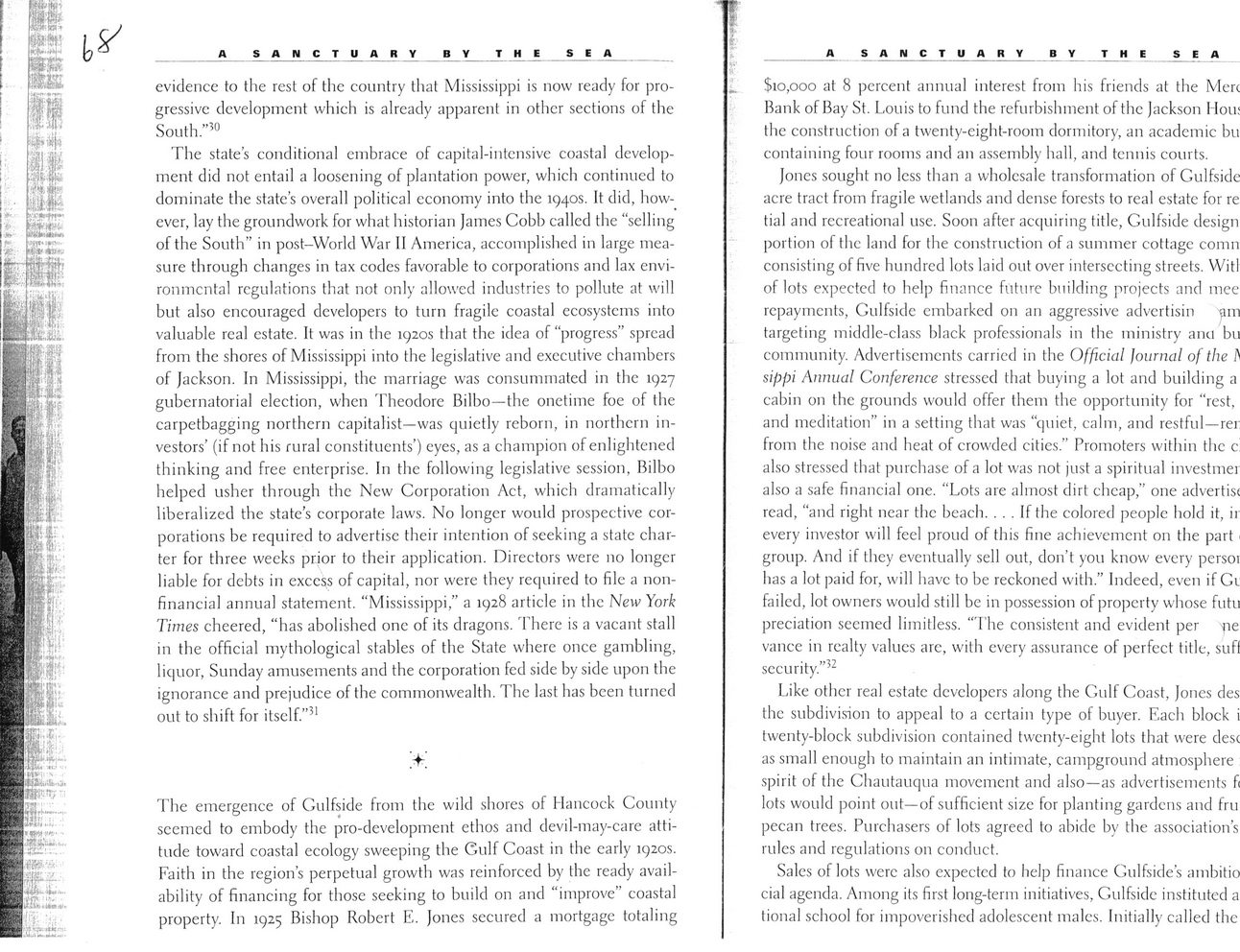This text was obtained via automated optical character recognition.
It has not been edited and may therefore contain several errors.
evidence to the rest of the country that Mississippi is now ready for progressive development which is already apparent in other sections of the South.”30 The state’s conditional embrace of capital-intensive coastal development did not entail a loosening of plantation power, which continued to dominate the state’s overall political economy into the 1940s. It did, however, lay the groundwork for what historian James Cobb callcd the “selling of the South” in post-World War II America, accomplished in large measure through changes in tax codes favorable to corporations and lax environmental regulations that not only allowed industries to pollute at will but also encouraged developers to turn fragile coastal ecosystems into valuable real estate. It was in the 1920s that the idea of “progress” spread from the shores of Mississippi into the legislative and executive chambers of Jackson. In Mississippi, the marriage was consummated in the 1927 gubernatorial election, when Theodore Bilbo—the onetime foe of the carpetbagging northern capitalist—was quietly reborn, in northern investors’ (if not his rural constituents’) eyes, as a champion of enlightened thinking and free enterprise. In the following legislative session, Bilbo helped usher through the New Corporation Act, which dramatically liberalized the state’s corporate laws. No longer would prospective corporations be required to advertise their intention of seeking a state charter for three weeks prior to their application. Directors were no longer liable for debts in excess of capital, nor were they required to file a non-financial annual statement. “Mississippi,” a 1928 article in the New York Times cheered, “has abolished one of its dragons. There is a vacant stall in the official mythological stables of the State where once gambling, liquor, Sunday amusements and the corporation fed side by side upon the ignorance and prejudice of the commonwealth. The last has been turned out to shift for itself.”31 >; The emergence of Gulfside from the wild shores of Hancock County seemed to embody the pro-development ethos and devil-may-care attitude toward coastal ecology sweeping the Gulf Coast in the early 1920s. Faith in the region’s perpetual growth was reinforced by the ready availability of financing for those seeking to build on and “improve” coastal property. In 1925 Bishop Robert E. Jones secured a mortgage totaling A SANCTUARY BV THE SEA $10,000 at 8 percent annual interest from his friends at the Merc Bank of Bay St. Louis to fund the refurbishment of the Jackson Hon; the construction of a twenty-eight-room dormitory, an academic bu containing four rooms and an assembly hall, and tennis courts. Jones sought no less than a wholesale transformation of Gulfside acre tract from fragile wetlands and dense forests to real estate for re tial and recreational use. Soon after acquiring title, Gulfside design portion of the land for the construction of a summer cottage comn consisting of five hundred lots laid out over intersecting streets. Witl of lots expected to help finance future building projects and mee repayments, Gulfside embarked on an aggressive advertisin ym targeting middle-class black professionals in the ministry ana bu community. Advertisements carried in the Official journal of the I\ sippi Annual Conference stressed that buying a lot and building a cabin on the grounds would offer them the opportunity for “rest, and meditation” in a setting that was “quiet, calm, and restful—rei: from the noise and heat of crowded cities.” Promoters within the c' also stressed that purchase of a lot was not just a spiritual investmer also a safe financial one. “Lots are almost dirt cheap,” one advertise read, “and right near the beach. ... If the colored people hold it, ir every investor will feel proud of this fine achievement on the part 1 group. And if they eventually sell out, don’t you know every persoi has a lot paid for, will have to be reckoned with.” Indeed, even if Gi failed, lot owners would still be in possession of property whose futu predation seemed limitless. “The consistent and evident per ne vance in realty values are, with every assurance of perfect title, suff security. yL Like other real estate developers along the Gulf Coast, Jones des the subdivision to appeal to a certain type of buyer. Each block i twenty-block subdivision contained twenty-eight lots that were desc as small enough to maintain an intimate, campground atmosphere : spirit of the Chautauqua movement and also—as advertisements f< lots would point out—of sufficient size for planting gardens and fru pecan trees. Purchasers of lots agreed to abide by the association’s rules and regulations on conduct. Sales of lots were also expected to help finance Gulfside s ambitio cial agenda. Among its first long-term initiatives, Gulfside instituted a tional school for impoverished adolescent males. Initially called the

Gulfside Methodist Assembly Land-was-Ours---book-Kahrl-(06)